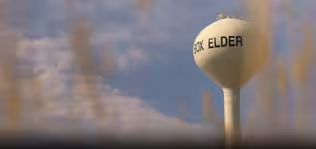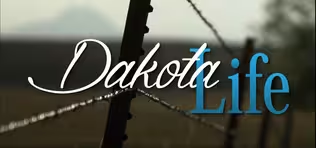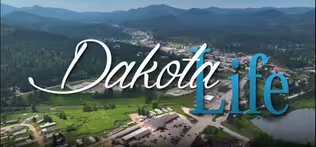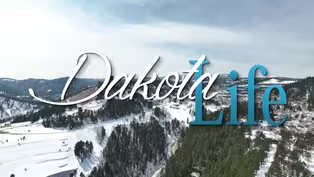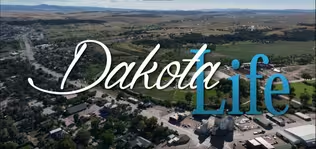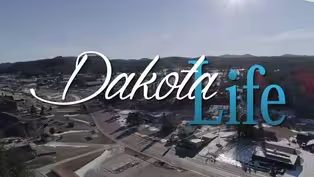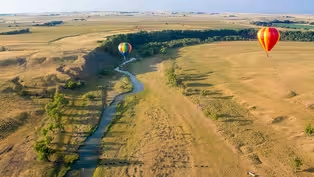Dakota Life
Greetings from Buffalo
Season 25 Episode 5 | 27m 56sVideo has Closed Captions
Greetings from Buffalo
Join us as we spend a day with the Painter family ranch as they work cattle. We visit Riley Pass, the site of a reclamation project, to restore the landscape to its original beauty. Tour the Northwest Regional Library and learn how they serve the local residents with a staff of one person. And we introduce you to a local columnist that keeps people up-to-date on Harding County.
Problems playing video? | Closed Captioning Feedback
Problems playing video? | Closed Captioning Feedback
Dakota Life is a local public television program presented by SDPB
Support Dakota Life with a gift to the Friends of Public Broadcasting
Dakota Life
Greetings from Buffalo
Season 25 Episode 5 | 27m 56sVideo has Closed Captions
Join us as we spend a day with the Painter family ranch as they work cattle. We visit Riley Pass, the site of a reclamation project, to restore the landscape to its original beauty. Tour the Northwest Regional Library and learn how they serve the local residents with a staff of one person. And we introduce you to a local columnist that keeps people up-to-date on Harding County.
Problems playing video? | Closed Captioning Feedback
How to Watch Dakota Life
Dakota Life is available to stream on pbs.org and the free PBS App, available on iPhone, Apple TV, Android TV, Android smartphones, Amazon Fire TV, Amazon Fire Tablet, Roku, Samsung Smart TV, and Vizio.
Providing Support for PBS.org
Learn Moreabout PBS online sponsorshipMore from This Collection
Dakota Life stories from towns in western South Dakota
Video has Closed Captions
The community of Box Elder is one of the fastest-growing cities in South Dakota. (28m 52s)
Video has Closed Captions
Greetings from the ranching community of Union Center. (27m 53s)
Video has Closed Captions
Visit an artist coop, the state railroad museum, gardening enthusiasts, and an annual film (25m 49s)
Video has Closed Captions
Dakota Life visits Custer and the surrounding area. (24m 56s)
Dakota Life: Postcard from Hot Springs
Video has Closed Captions
Dakota Life: Postcard from Hot Springs (29m 49s)
Providing Support for PBS.org
Learn Moreabout PBS online sponsorshipq(relaxed music) - [Announcer] This is a production of South Dakota Public Broadcasting.
(relaxed music continues) - In the far Northwestern corner of South Dakota, Harding County occupies a landscape unlike any other.
To the north, the Cave Hills with level topped buttes that drop sharply to the prairie below.
Steep walled cliffs are honeycombed with small caves and elegant natural arches.
Stone canvases feature petroglyphs, some hundreds, others perhaps thousands of years old.
Many Native American artworks and artifacts were documented in and around the cave named for William Ludlow.
Ludlow was Chief Army engineer on the Custer expedition of 1874.
And in size, depiction of a bison and a calf may be the most famous image to come out of the Cave Hills.
In the southwest of Harding County, clusters of Ponderosa pine forest called long pines and short pines dot the rolling Prairie.
Near the southwest county line are the Crow buttes, site of the spot in 1822, the battle between the Crow and the Lakota warriors memorialized in ledger art.
To the east are the Slim Buttes.
That's home to pronghorn antelope that graze among the spring fed gullies and the brushy draws, and nearby sandstone buttes like Battleship Rock, The Castles, and Window Rock stand watch.
Oglala Lakota ledger artist and cultural historian, Amos Bad Heart Bull, included the Slim Buttes in his 1890 map of culturally significant sites in and around the Black Hills.
When Bad Heart Bull was still a boy, the half starved cavalry of General George Crook made their Horsemeat March.
They were in pursuit of the Lakota that had routed Custer's Seventh Calvary at the Battle of the Little Bighorn.
The unique geological and historic sites like the Cave Hills or Slim Buttes rise above a foundation of rolling shortgrass prairie.
The weather is a climate of arid hot summers and harsh winters.
The first Europeans to migrate to this far northwest corner were buffalo hunters who sold hides to eastern buyers.
The hunters were followed by ranchers, but the harsh winter of 1886 and '87 killed thousands of cattle.
Some of those larger outfits never recovered their position in the region.
In those days, this area was part of a larger Butte County, which really covered most of northwest South Dakota but the people at the northern end voted to strike out on their own, and they subdivided Butte County into Harding County and Perkins Counties following the customary inner town contest over who would be the county seat.
But today, we're in the winner for Harding County.
Welcome to "Dakota Life," and greetings from Buffalo.
(upbeat music) Support for this program comes from the Olsen family of businesses, serving Harding County and Western South Dakota.
Whatever your needs, we've got you covered.
And by Pioneer Bank & Trust, providing personal, agriculture, and commercial banking services to Western South Dakota for more than 100 years.
Pioneer Bank & Trust is local, member FDIC.
There was a battle for the Harding County seat.
Camp Crook was the natural choice.
It was the oldest and most populous town, but some settlers near the center of the county thought Camp Crook was too far west, just a stone's throw from the Montana state line.
Two of those settlers were Ray and Frank Gilbert.
They bought a store on the south fork of the Grand River, and soon, they had a town.
It had a bank, two newspapers, a hotel, dance hall, and two saloons.
In 1909, devotes of both towns bribed, wooed, and cajoled voters and county officials, but Buffalo triumphed in the end.
Buffalo's growth spurt was short-lived.
Ranches consolidated, and population numbers were already in decline soon after Buffalo was founded.
Another factor that limited growth was that the railroads never laid any track into Harding County.
The closest depot to Buffalo was nearly 50 miles away in Bowman, North Dakota.
Buffalo's economic base, culture, and way of life really hasn't changed all that much since 1909.
Though in recent years, oil and gas exploration has provided additional jobs.
It's not the Bakken Formation behind the boom in North Dakota, but it's just enough to give some a chance to stick around.
Coming up, we'll see how Buffalo residents stay abreast of local news and what their neighbors are up to.
We'll see the unique way the Northwest Regional Library serves Buffalo and the surrounding area and visit part of this extraordinary landscape that's recovering from strip mining from 50 years ago.
But first, SDPB's, Lura Roti, visited the Painter Family Ranch where running cattle on Harding County grasslands has been a family legacy since 1895.
(gentle acoustic music) - [Lura] Ask Jessica Holmes how old she was when she began working cattle with her family, and the fifth generation rancher has this response.
- Oh wow.
I honestly can't remember because I probably would've been a toddler thrown on with my mom's horse or just around.
So I'm not really sure the age I was ever helpful working cattle, but I wouldn't be able to put an actual date on it 'cause kind of forever, I guess.
- [Lura] This fall day, Jessica and her husband, Casey, are preg testing a group of cattle the family moved home for the winter.
In addition to learning pregnancy rates and due dates through ultrasound, when the cows are in the chute, they receive a vaccination, fly control treatment, an identification tag, and a brand.
With about 200 heads to work before dark, Jessica's three children, Tommy, Trey, and Chase, her parents, Joe and Cindy Painter, and employee TK Cohen are all in the corral helping out.
- [Jessica] Oh, there's a lot of teamwork that goes into working the cattle, and, generally, the more people you have with you helping, the smoother it goes.
- [Lura] Jessica and Casey left successful careers in Rapid City to work full-time with her parents on the family's Harding County ranch 10 years ago because this is where they wanted to raise their children.
- It truly is just an awesome lifestyle.
It's a lot of work, but, I mean, it's different than an office job.
You might have to put in 100 hour weeks sometimes, and then the next week, you might need to make time for...
I'm able to coach my daughter's basketball team.
- [Lura] Jessica's mom, Cindy Painter, can relate.
- I enjoyed the most is I got to raise my own children, and we work together every day.
Even at a young age, as you can see, we work together every day, and it's just so blessed.
Jessie and her husband came back to the ranch with our three grandchildren.
Although I'd like to have the other two, but I know that it's not always possible to have 'em all come back.
- [Lura] Cindy and Joe's grandchildren are the sixth generation to continue the Painter Ranch legacy.
It's a legacy that goes back nearly 130 years, explains Joe Painter.
- My great-grandfather worked for the CY Cattle Company, and he rode into this country in 1895.
- [Lura] Joe says it's taken grit, determination, and a little outside help to keep things going.
- Times were so tough when we got started.
We just about... She had a degree in accounting, and I had a degree in business management with a minor in money and banking, and we just about had to leave to go to town to get a jobs.
The bankers wouldn't work with us at all.
Well, it wouldn't be for my grandma Painter lending us $10,000 for feed one winter, and without that we wouldn't have been here.
- [Lura] Joe says the fact Jessica and Casey and their family are here today make all the sacrifices and challenges worth it.
- [Joe] That's our whole goal.
Otherwise, you really wouldn't be pushing or expanding or anything.
You don't expand for yourself.
You expand thinking about the way the grandkids can get going.
- You may not be surprised to know that some of the biggest stars out in this area have been the four-legged kind.
One in particular was a gray wolf, better known for missing a toe.
Starting in 1912, Three Toes ran a 13 year reign of terror against cattle and sheep in Harding County.
He was one of the last of the buffalo wolves, an extinct subspecies of gray wolf.
He seemed to taunt his pursuers and gradually gained their respect.
Local sheep herder and writer, Archie Gilfillan, put it this way.
"Three Toes laughed at poison, traps, and guns "and lived in and off enemy country "with a hand of every man against him.
"He was a cunning, blood thirsty killer, "a super wolf among wolves, "and the single most destructive animal "of which there is any record anywhere."
He continued to ravage the prairie into the 1920s, killing an estimated $50,000 worth of sheep and cattle.
Well, ranchers finally called in reinforcements.
Federal wolf hunter, Clyde Briggs, flew in from New Mexico.
After three weeks of working his trap line.
Briggs snagged his prey.
He muzzled old three toes with the intent to deliver him to Rapid City alive, but captivity wasn't for the old wolf.
While en route, "Briggs stopped the car," (indistinct) Gilfillan, "And looking around, "found the wolf's eyes fixed on him, "but the eyes did not see him, "for the wolf was dead.
"Call it a broken heart or what you will.
"Something of this sort is what killed the old wolf."
Buffalo wolves no longer range in the hills of Harding County, but the coyotes and the mountain lions do.
Out among the bad lands, caverns, and the hoodoos, there's a national forest.
The Custer Gallatin National Forest stretches from Harding County all the way to Yellowstone.
Other wildlife native to this area includes antelope, deer, grouse, turkeys, some elk, and the occasional black bear.
Camping in the forest is primitive, but it's free.
A part of this extraordinary landscape northwest of Buffalo, known as Riley Pass, was scarred by strip mining, but it's on the way back.
- [Lura] The North Cave Hills of the Custer Gallatin National Forest is home to a diverse natural landscape of sandstone bluffs, prairie grasses, deciduous forest, and Ponderosa pine.
It's a special place, a place of natural beauty and cultural significance.
Riley Pass is also a landscape scarred by strip mining.
- What they left behind is all the sedimentary geology in the Fort Union Formation was not only left over uranium and the coal seams in piles out here, but the sedimentary layers here also have high levels of arsenic, molybdenum, and selenium, all of which are the other contaminants of concern that we're trying to target out here with our reclamation.
And when they left, all of that was left exposed to the elements.
It's been subject to erosion, particularly water erosion running down the hill off the forest onto private land.
- [Lura] The strip mining occurred throughout the 1950s and '60s to meet Cold War demand for uranium.
- [Kurt] I call it our version of the Gold Rush out here 'cause there was a lot of exploration and then some larger mining activities that went on.
- [Lura] Hansen said when he came to Riley Pass 15 years ago, the damage left behind was immense, and the cost of reclamation so great he did not see much hope.
And then in 2015, the Department of Justice stepped in.
- The Department of Justice negotiated a nationwide lawsuit settlement with Anadarko Oil, which had bought out Kerr-McGee, which was the company that operated out here.
And we were able to get a large portion of money from that lawsuit settlement to fund the work that we're doing out here today.
- [Lura] Of the $5 billion settlement, more than 150 million is allocated to reclamation of Riley Pass.
- Historically, mine reclamation employs very geometric forms, long linear slopes often using non-native materials, and it's been proven that these require a fair amount of care and maintenance over the years.
What we're doing here at Riley Pass is trying to use the natural landform that exists around the site and implement that into our reclamation plan.
- [Lura] Utilizing historical maps, pre-mining photos of the area, and the surrounding landscape as a guide, reclamation designs are created with specialized software and GPS-guided construction equipment is used to shape the landscape to what it originally looked like.
- [Kurt] I mean, literally these guys are driving around with bulldozers looking at a computer screen and saying, dig here, fill here all across these steep slopes out here.
- [Lura] One of the first steps to Landform reclamation in Riley Pass is locating the rim rock.
- [Peter] There is a sandstone ledge that defines all of the buttes in this area.
That is kind of our anchor point where we begin all of our designs.
- [Lura] Reclamation work is currently underway on bluff B.
- Today we have Nick in the excavator.
He's trying to find the edge and the depth of the bluff, so that the engineering company Tetra Tech can come in and do the design for like it was pre-mining conditions.
- [Lura] These towering sandstone bluffs, according to Peter Werner, are more than unique geological features.
For many, he says they hold cultural significance.
- [Peter] This is arguably one of the highest concentrations of historical and religious artifacts in the Northern Great Plains.
It carries a great deal of importance to the First Peoples.
- [Lura] Since 2015, 120 acres of landscape have been reclaimed.
An important aspect of the Riley Pass Landform Reclamation Project is containing harmful minerals, so the land is once again safe for all.
- Living in one of South Dakota's least populous counties has its challenges.
Services people take for granted in larger cities wouldn't be available without a sense of civic duty.
For instance, when emergencies can happen in Harding County, people in need can rely on a network of volunteer first responders, from paramedics and nurses to ambulance drivers, all donating time to training and taking calls at any time, day or night.
The Buffalo area is known for producing a reliable crop of rodeo talent.
Families like the sixth generation ranchers, Riley and Jessica Routier, grew up in rodeo.
Now they're passing that tradition onto their own kids.
Jessica has competed in barrel racing at the National Finals Rodeo the last three years in a row.
Among the next generation, Braden has competed at the South Dakota State High School Rodeo finals, and Payton has thrilled crowds as a trick rider.
Sawyer Gilbert, who grew up on the Gilbert Angus Ranch, won the 2021 WPRA World Championship in breakaway roping.
Her younger brother, Grey, competed in steer wrestling and tie down roping in the 2022 National High School Rodeo Finals.
There are creative outlets for everyone around here.
The Prairie Points Quilting Guild brings camaraderie and critique to local needle artists.
Quilters meet monthly at the County Rec Center, and they host an annual Memorial Day quilt show.
When you wanna get the local news, the real local news about what your neighbors are up to you look to the "North Camp Crook News" column in the "Bowman County Pioneer."
- [Greg] Growing up on our ranch outside of Buffalo in a time before TV, Paula Richter developed many skills including the ability to write.
- Our mother was a stickler for writing letters.
She made us write a letter every week.
We had to write to somebody like our great grandma in Washington state.
- [Greg] In writing those letters, Paula developed a love for writing.
- I started writing.
Well, I liked writing throughout my childhood and in high school, but I actually started doing journalistic writing when I was in college, and I took a couple courses and I worked for the college newspaper.
- [Greg] After gaining that experience working in the world of newspapers, that led to Paula's first column, "The Featherduster."
- Well, at that time, I was just trying to think of something, and it's like you yank a feather out and use it for a quill is how that got started.
And then when I was trucking, it was my handle.
My CB handle was Featherduster.
"The Featherduster" is just whatever I happen to be thinking about that I deem important for that week.
- [Greg] "The Featherduster" still goes out every week, but that's not the only column she writes.
- My mother was writing the "North Camp Crook News."
She was doing that after our friend Marge Catrin quit doing it, and she asked mom if she would take it over.
And then mom would have me write when she couldn't be there.
And then, when she died in 2011, then I took it over.
The only bad part of it is when I opened the paper and I see a mistake has been made, and everybody's reading it, oh, this is a terrible moment.
But other than that, it's quite fun.
It's wonderful to keep up with the neighbors, what they're doing, and just to connect with them.
- [Greg] And the "North Creek Camp News" is all local all the time.
- The news is actually what our neighbors have been doing, which our neighbors are amazing.
They do so many wonderful things.
I mean, we have the Painters.
We have Jesse Vale.
We have, I mean, people that go way out of the community and do amazing things too.
And then we have people that are right here that are doing amazing things as well.
- [Greg] With the "North Creek Camp News" being published in Buffalo, Bowman County, North Dakota and Baker, Montana, it gives residents of Harding County both past and present a way to keep up with their neighbors.
- It's just fun to sit down and just tell things.
That's all it is.
(caller murmurs) Oh, are you really?
Well, quickly think of something, and then I'll write it down and then we'll go.
I mean, you won't find these sorts of columns anywhere else probably.
Well, maybe you do, but I'm thinking in rural areas because when you have so many people like Sioux Falls, if you had, say, "The Brandon," she'd be on the phone for days trying to get everybody called.
(laughs) You see what I mean?
But it's really sad to me because everybody has a story.
Everybody has done stuff that's interesting.
That's the fun part is finding out what the story is.
It's really cool.
- In the 1980s and '90s, Buffalo Sacrison twins, Stan and Steve, became fossil hunting celebrities.
Their most famous find was a Tyrannosaurus Rex skeleton more than 60% complete.
Stan the T-Rex shattered records when it's sold for nearly $32 million at Christie's Auction in 2020.
A few years after Stan Sacrison found his namesake, he uncovered another T-Rex nicknamed Duffy about a half mile away.
Later, Steve found a Triceratops skeleton near there too.
In 2012, another Buffalo fossil hunter named John Carter uncovered a 700 pound skull thought to be a newly discovered species of Ceratopsian, the dinosaur family that includes the Triceratops.
Paleontologists and fossil hunters like John Carter still scour the jagged sandstone fossil beds of the Hell Creek Formation.
They're looking for the next Stan or the next Sue as pre-historic artifacts have become one of the Buffalo area's most famous exports.
Perhaps it's fitting for a place where the times like the landscape have been slow to change.
Back in Buffalo at the Northwest Regional Library, their goal is to be the best possible library to all residents of the area and promote lifelong learning and a love of reading.
A lot gets done between being open a few days a week and with a staff of one.
(phone rings) - Northwest Regional Library, Vicki speaking.
- [Greg] In 2005, Buffalo would look to open the Northwest Regional Library.
The building was in place, the books were in place, but the question was who would run the library?
Enter Vicki Anderson.
- [Vicki] I had been looking for a job for a long time.
Application was in the paper.
In the paper that you were looking for...
I finally picked this job.
And I called one of the board members.
She said, "You'd be good.
"Go ahead and apply for it."
- [Greg] The list of requirements was still sort of a work in progress, but Vicki had that one trait that made her perfect for the job.
- One thing I had put on mine that I liked to read.
I mean, I didn't know anything about libraries, and they they hired me 'cause I liked to read.
- [Greg] Thus, Vicki became the library's first and only employee, learning about libraries with on-the-job training and getting her degree in library sciences from New Mexico State University.
One of Vicki's first tasks, drawing people into the library.
- It just went like the "Field of Dreams," "If you build it, they'll come," and they have come.
People are just wonderful.
Maybe I'll have 10, 15 people in the library in a day, which sounds like not very many people, but for Buffalo with 320 population, it's good.
- [Greg] And after being open for more than 15 years, every day is still just as interesting as day one.
- Thank you so much.
- Thank you, Joey.
You come in, you open the door, you check the book drop, turn on the computers, turn on the lights, turn on the open sign, and then you start your day.
So, I will check those books in that came in the book drop.
I'll start cataloging new books.
I save books for people.
I know what they like, and I save 'em.
There's piles on my table out there.
That way when they come in, they've got the books that they like.
And they're in order.
So you gotta make sure you get 'em in order.
- [Greg] gOne of her favorite tasks is every third Tuesday of the month when Vicki and her husband fire up the Harding County Book Mobile.
It's been making that 140 mile round trip ever since the 1960s.
- I say in the Book Mobile, that's where I get the most kids.
And I have eight kids at each school.
I have two schools, Camp Crook and Ludlow.
And those kids just, oh, I found the book that I've been looking for.
And it just makes you feel like, yes, you did.
You got the right books.
They're just so happy.
And if the Book Mobile is not gonna go when it's supposed to go, kids are very sad.
- [Greg] While this all may seem like a lot of work for one person, for Vicki, the reward comes knowing that the residents of Buffalo and Harding County are able to escape into the world of books.
- It's a blessing for Buffalo.
I don't know if everybody agrees with that.
I mean, there's people in the county that thinks we're paying too much rent for this building, or there's people that think we don't need to order all these books and that kind of thing, but it's like a refuge, a place they can get what they want and they don't have to buy it.
They can get books here for nothing, so it's a good thing.
It's a good thing.
Thank you, bye.
(Vicki laughs) - Not many people have ever laid eyes on the natural wonders of Harding County.
Even pictures of the many natural and human-made wonders here are hard to find.
Instagram hasn't really discovered this country yet, But Amos Bad Heart Bull knew it.
As an artist and a tribal historian, he documented its cultural significance.
To see this country is to step into another world.
Time seems to move slowly and stretch on for eons past the earliest petroglyphs into the days when Tyrannosaurus and Triceratops grazed around here.
Solitude isn't hard to find.
Archie Gilfillan compared driving the gumbo roads after dark to a comet, rushing through a desolate void.
Buffalo might have grown into a larger cow town if the blizzards of 1886 and '87 hadn't broken the cattle barons, or if a rail line had laid tracks into town.
Archie Gilfillan lamented that, "The further we advance in civilization, "the more we wrap ourselves about "with strand after strand of protective filament "until finally we become mere preambulating cocoons "with whatever life is left in us.
"going on beneath the surface."
Buffalo is still a place where one can step outside of that cocoon with an undeterred wind, stars above, and gumbo underfoot.
If you prescribe to South Dakota being a land of infinite variety, you won't really understand it until you have a visit here.
You can revisit stories about Buffalo and our other communities at sdpb.org/dakotalife.
Thanks for coming along with us.
I'm Larry Rohrer.
For all of us at SDPB, thanks for watching.
(upbeat music)
Support for PBS provided by:
Dakota Life is a local public television program presented by SDPB
Support Dakota Life with a gift to the Friends of Public Broadcasting
